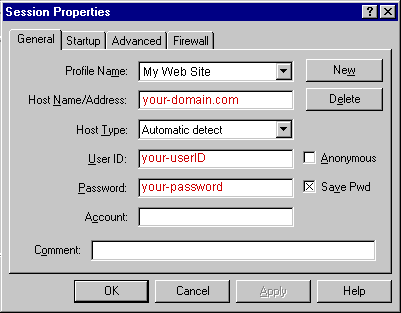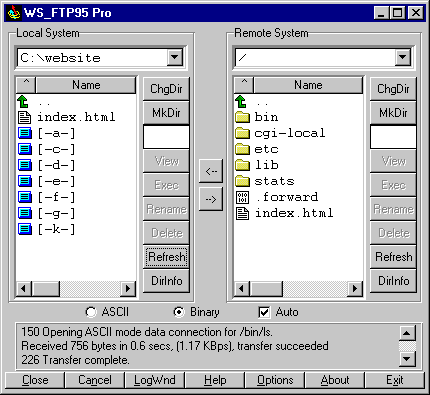Getting started with FTP
The process by which files are transferred to the web server is called "FTP"
(File Transport Protocol). You have unlimited access via FTP 24-hours a day. As such, you
can create and maintain your web pages on your own computer and upload files to your web
site at your leisure.
Internet providers such as AOL, Compuserve, and Prodigy may have a built-in FTP
interface. If you have a PPP internet account and need an FTP program, you can download
software for for either the PC or Mac below. PC users should download WinZip if you do not already have a program
to extract .zip files.
Microsoft FrontPage Users
Customers with Microsoft FrontPage extensions installed on their sites should use
only the FrontPage publishing feature to transfer files. Using regular
FTP can corrupt the extensions, disabling the functionality of the FrontPage web and
requiring that the site be deleted to reinstall the extensions. |
Configuring Your FTP Software
The following information is contained within your account activation notice and is
needed to connect to your web site via FTP:
- USERID
- TEMP PASSWORD
- FTP HOSTNAME
The hostname tells your FTP software to connect to the web server upon which your web
site resides. In general, the process of configuring the various FTP software programs is
the same. We recommend WS_FTP for PC computer users and will be using it in the upcoming
examples.
Each time you run WS_FTP the Session Profile window will be displayed. A profile
contains the information needed to connect to your web site. Creating a profile now will
eliminate the need for you to configure the software each time you wish to connect to the
web server via FTP. To create a new profile, click the "New" button and enter a
generic profile name at the top of the Session Profile window. Next, enter the userid,
password and hostname for your web site as illustrated below.
Fig.1

Be sure to select "Auto detect" for the Host Type. (see Fig.1) It is best to
select "Save Password" and "Auto Save Config" to maintain these
settings for future use. All other fields can be left blank. You are now ready to connect
to the web server. Click "Ok" to continue.
How to Transfer Files
When you connect to the web server, you will connect directly to the root
("home") directory of your account. WS_FTP will display a split screen where
files on the left-hand side are within your own computer. (see Fig.2) You will see several
folders on the right-hand side such as bin, cgi-local, dev, etc, lib, and stats which are
landmarks suggesting a successful connection to your web site.
Fig.2

You can transfer files directly to the root level and/or create subdirectories. The
only system directory that you may need to use is cgi-local; this
directory is reserved for custom scripts written in Perl, Unix Shell, or C. (C programs
must first be compiled by BCG Canada Inc. before they will work.)
To make your home page load automatically, name the HTML document
"index.htm" or "index.html" in lowercase and upload it to the root
directory of your account. To upload a file or files, simply highlight the file(s) on the
left and click the right-arrow button ("-->") in the center of the screen.
Be sure to upload HTML documents and scripts in ASCII mode and images
in BINARY mode. To transfer a file to a subdirectory, double-click the
appropriate subdirectory to open it before transferring the desired file(s).
As soon as a file is uploaded to the web server, it is available for all to see. If,
after uploading a file, you are still unable to see the updated file via Netscape, you
need to clear both disk and browser cache. This function can be found by selecting Options
> Network Preferences in Netscape. Remember that you must first be connected to the
internet through your local internet service provider in order to connect to the web
server.
Acceptable File Names
Our operating system (IRIX) is case sensitive. In other words, the file name
"faq.html" is NOT the same as "FAQ.html". If your HTML code references
a faq.html, but the actual file name is in uppercase, this will result in a File Not Found
error. This applies to directory names as well.
To prevent errors, we suggest naming all files in lowercase. Spaces and and special
control characters are generally not a good idea. The underscore character ("_")
is acceptable. You should avoid special characters ( ! @ # $ % ^ & * : ' ) in file
names. We suggest that you keep the length of file names to a minimum. The tilde (~)
cannot be used in directory or file names.
Notes to Mac Users
Select "raw data" transfer mode when using Fetch to transfer both HTML and
images.
PageMill may add either a .bin or .txt extension to your files which must be removed in
order for such files to load properly.
Viewing Web Pages in Netscape
Webmasters often modify an HTML document and re-upload it to the server. After
returning to their web browser they click RELOAD only to find the original document
unchanged. This is a common occurrence for Netscape users and is easily remedied by
clearing the browser's disk cache. This can be done in Netscape under Options > Network
Preferences.
What should I do if denied access via FTP?
- If you can access your account Control Panel, but cannot access your account via FTP,
the FTP configurations may be incorrect.
- If you are denied access AFTER entering your userid and password, you may be using the
wrong password. Check the activation notice sent to you via email when the account was
first set up. If you changed your password and it doesn't seem to be working, contact support to reset your password.
- If you cannot connect at all, or connect and then "hang", there may be
problems with connectivity. You can test your connection by going to
http://www.yourdomain.com/cgi-bin/secure/trgw-s while still connected to the
Internet. This program will take about 15-20 minutes to generate a report. You will need
to send the results to our support people so we can help you track the problem.
|
![]()